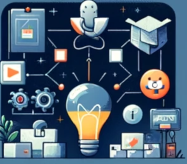The Journey of a Mobile App
Journey of App Development
This journey is not just about building an app; it's about creating a digital experience that resonates with users. Let's embark on this journey together, turning your idea into the next digital sensation.
Ideation and Conceptualization
 |
This initial phase is all about defining the core idea of the app. It involves brainstorming, market research, identifying the target audience, and understanding their needs. The goal is to refine the app's concept and establish clear objectives.
Planning |
 |
In the planning phase, you outline the app's features, functionalities, and the technology stack required to build it. This stage often includes creating a product roadmap and prioritizing features for the Minimum Viable Product (MVP).
UI/UX Design |
 |
The design phase focuses on the app's look and feel, ensuring it offers a user-friendly experience. It typically involves creating wireframes, mockups, and prototypes. Designers focus on user experience (UX) to make the app intuitive and user interface (UI) to make it visually appealing.
Development |
 |
| During the development stage, the app is brought to life. This phase is divided into two parts: frontend (client-side) and backend (server-side) development. Developers write the code necessary for the app's functionality, integrating various APIs, databases, and handling data processing. |
Testing and Quality Assurance (QA)
 |
Testing is crucial to identify and fix bugs or issues before the app goes live. This includes various types of tests such as unit testing, integration testing, performance testing, and user acceptance testing (UAT). The goal is to ensure the app is stable, usable, and secure.
Launch |
 |
Once the app passes the testing phase, it's ready for launch. This involves deploying the app to the app stores (Apple App Store for iOS apps and Google Play Store for Android apps), ensuring it meets all store guidelines. The launch phase may also include marketing activities to promote the app.
Post-Launch Support and Maintenance |
 |
After the app is live, it requires ongoing support and maintenance. This includes monitoring app performance, user feedback, and analytics, as well as releasing updates to add new features or fix bugs. This stage is crucial for keeping the app relevant and maintaining a good user experience.
Evaluation and Iteration |
 |
| Finally, regularly evaluating the app's performance and user feedback is essential for long-term success. This can lead to iterations where the app undergoes further development to introduce new features or improvements based on users' needs and market trends. |











Comments
Post a Comment